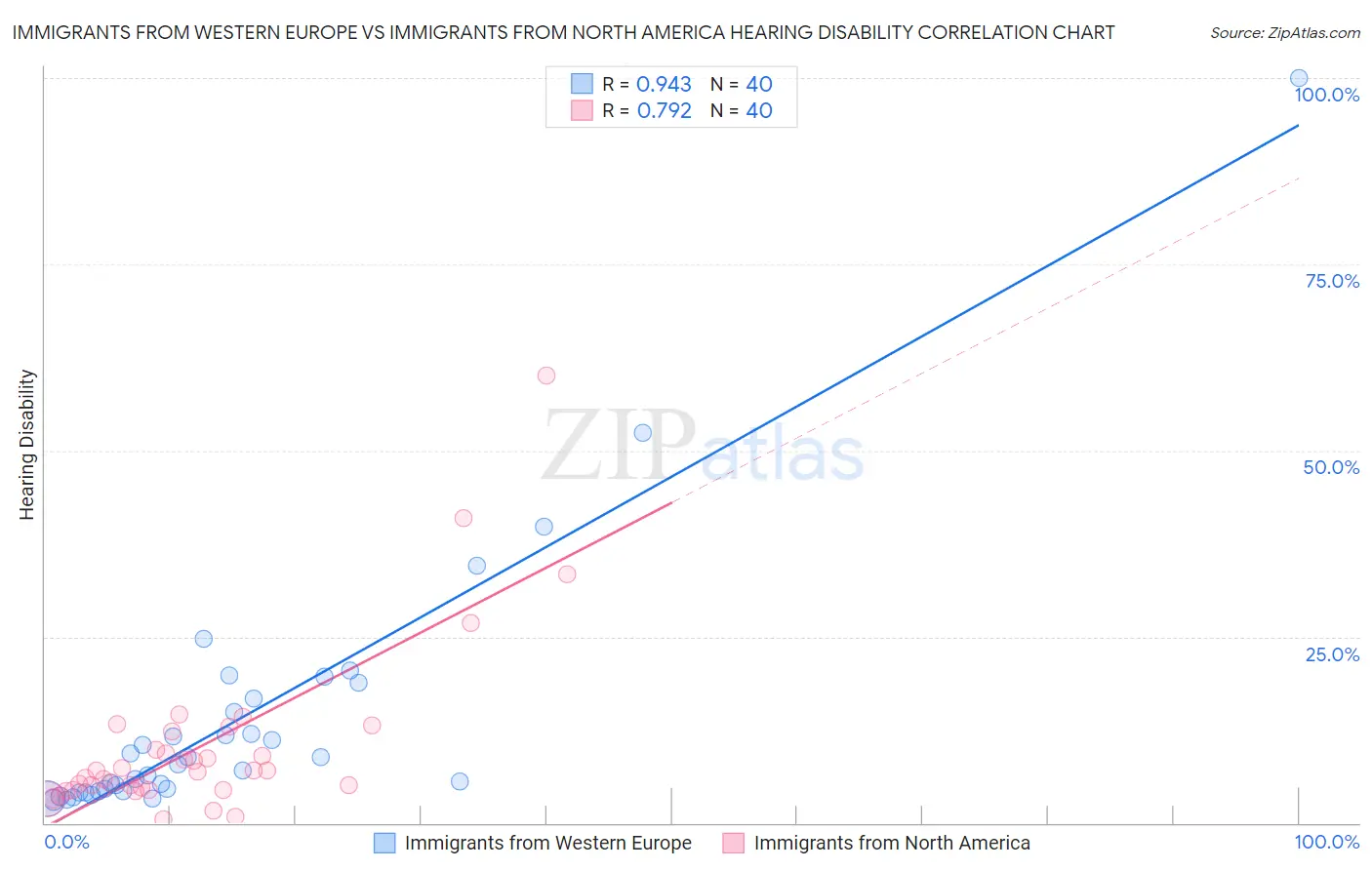Immigrants from Western Europe vs Immigrants from North America Hearing Disability
COMPARE
Immigrants from Western Europe
Immigrants from North America
Hearing Disability
Hearing Disability Comparison
Immigrants from Western Europe
Immigrants from North America
3.3%
HEARING DISABILITY
1.0/ 100
METRIC RATING
243rd/ 347
METRIC RANK
3.5%
HEARING DISABILITY
0.1/ 100
METRIC RATING
262nd/ 347
METRIC RANK
Immigrants from Western Europe vs Immigrants from North America Hearing Disability Correlation Chart
The statistical analysis conducted on geographies consisting of 493,839,784 people shows a near-perfect positive correlation between the proportion of Immigrants from Western Europe and percentage of population with hearing disability in the United States with a correlation coefficient (R) of 0.943 and weighted average of 3.3%. Similarly, the statistical analysis conducted on geographies consisting of 462,279,927 people shows a strong positive correlation between the proportion of Immigrants from North America and percentage of population with hearing disability in the United States with a correlation coefficient (R) of 0.792 and weighted average of 3.5%, a difference of 4.3%.

Hearing Disability Correlation Summary
| Measurement | Immigrants from Western Europe | Immigrants from North America |
| Minimum | 3.1% | 0.49% |
| Maximum | 100.0% | 60.0% |
| Range | 96.9% | 59.5% |
| Mean | 13.6% | 10.2% |
| Median | 7.5% | 7.0% |
| Interquartile 25% (IQ1) | 4.3% | 4.5% |
| Interquartile 75% (IQ3) | 15.8% | 11.0% |
| Interquartile Range (IQR) | 11.5% | 6.6% |
| Standard Deviation (Sample) | 17.7% | 11.5% |
| Standard Deviation (Population) | 17.4% | 11.3% |
Demographics Similar to Immigrants from Western Europe and Immigrants from North America by Hearing Disability
In terms of hearing disability, the demographic groups most similar to Immigrants from Western Europe are Assyrian/Chaldean/Syriac (3.3%, a difference of 0.070%), Yugoslavian (3.3%, a difference of 0.17%), Immigrants from Scotland (3.3%, a difference of 0.41%), Immigrants from England (3.3%, a difference of 0.69%), and Lithuanian (3.4%, a difference of 0.90%). Similarly, the demographic groups most similar to Immigrants from North America are Hawaiian (3.5%, a difference of 0.11%), Portuguese (3.5%, a difference of 0.15%), Slovene (3.5%, a difference of 0.23%), Northern European (3.4%, a difference of 0.47%), and Yaqui (3.4%, a difference of 0.53%).
| Demographics | Rating | Rank | Hearing Disability |
| Yugoslavians | 1.0 /100 | #242 | Tragic 3.3% |
| Immigrants | Western Europe | 1.0 /100 | #243 | Tragic 3.3% |
| Assyrians/Chaldeans/Syriacs | 0.9 /100 | #244 | Tragic 3.3% |
| Immigrants | Scotland | 0.8 /100 | #245 | Tragic 3.3% |
| Immigrants | England | 0.7 /100 | #246 | Tragic 3.3% |
| Lithuanians | 0.6 /100 | #247 | Tragic 3.4% |
| Austrians | 0.6 /100 | #248 | Tragic 3.4% |
| Italians | 0.4 /100 | #249 | Tragic 3.4% |
| Yuman | 0.4 /100 | #250 | Tragic 3.4% |
| Hungarians | 0.4 /100 | #251 | Tragic 3.4% |
| Croatians | 0.4 /100 | #252 | Tragic 3.4% |
| Carpatho Rusyns | 0.3 /100 | #253 | Tragic 3.4% |
| Slavs | 0.2 /100 | #254 | Tragic 3.4% |
| Poles | 0.2 /100 | #255 | Tragic 3.4% |
| Hmong | 0.2 /100 | #256 | Tragic 3.4% |
| Yaqui | 0.2 /100 | #257 | Tragic 3.4% |
| Northern Europeans | 0.2 /100 | #258 | Tragic 3.4% |
| Slovenes | 0.1 /100 | #259 | Tragic 3.5% |
| Portuguese | 0.1 /100 | #260 | Tragic 3.5% |
| Hawaiians | 0.1 /100 | #261 | Tragic 3.5% |
| Immigrants | North America | 0.1 /100 | #262 | Tragic 3.5% |